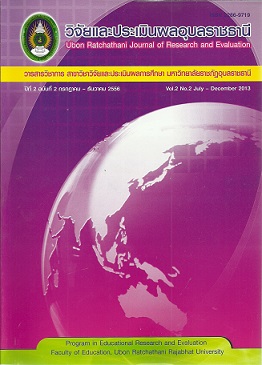Design of the Classroom Assessment and Evaluation Instrument in the Occupation and Technology Unit for Prathom Suksa 6 (Grade six)
Keywords:
การออกแบบเครื่องมือวัดประเมินผลในชั้นเรียน,การหาคุณภาพของเครื่องมือ,ครูและนักเรียนAbstract
The objectives of the research were to design the instrument to evaluate the classroom performance and to examine the quality of the instrument in question in the occupation and technology unit for Prathom Suksa six (Grade six). The target groups were 47 Prathom Suksa six students enrolled in the first semester of the academic year 2011 and three teachers teaching the occupation and technology unit in the same semester. The groups in the research were derived by a purposive sampling.
The instruments designed by the researcher were the tests on cognition, the formats to evaluate the performance skills, and the formats on the observation of the expressive behavior in learning. Statistics used in data analysis included mean, standard deviation. Statistics used in finding the instrument quality were the value of the index of congruence (IOC), the value of RAI, Cronbach’s Alpha coefficient, difficulty value and discrimination value.
The research findings were as follows:
- 1. Three measuring instruments were gained:
1.1 The tests on cognition had the value of index of congruence between 0.80-1.00, of difficulty (Po) between 0.42-0.83, of discrimination between 0.20-0.83, of the confidence
( ) 0.84, of mean at 37.76 and of the standard deviation equivalent to 11.30.
1.2 The performance skill assessment format consisted of:
1.2.1 On food preparing the value of the index of congruence between the objectives and the designated (IOC) was between 0.80 -1.00, of the index of congruence between the set scores and the scoring was between 0.80 -1.00.
1.2.2 On making the installation of the key chain peg the value of the index of congruence between the behavioral objectives and the assigned work (IOC) was between 0.80 – 1.00, of the index of congruence between the set scores and the scoring details was between 0.80 – 1.00.
1.2.3 On the invention of the appliances and the decorative items the value of index of congruence was 0.80 – 1.00, of the index of congruence between the set scores and the scoring details was between 0.80 – 1.00.
1.3 The model of the learning behavior was of three types: responsibility, interest, and group work. Its value of the index of congruence between the behavior and the learners’ characteristics was equivalent to 1.00. Two evaluators’ congruence value was equivalent to 1.00.
The handbook in the study as used by the three teachers in the instruction produced the following results.
- 1. On a handbook, it was found that it explained the patterns and objectives of the design as per the ideas and concepts of the standard criteria.
- 2. On the application it was found that the experimenters took time to study in order to understand the steps in a designing process.
- 3. On the benefits it was found that the experimenters knew how to construct and develop the evaluation instrument according to the principles of assessment anode evaluation.
References
4 (ตุลาคม–ธันวาคม 2547) : 8–18.
คณะกรรมการการศึกษาขั้นพื้นฐาน, สำนักงาน. เอกสารประกอบหลักสูตรแกนกลางการศึกษาขั้นพื้นฐาน พุทธศักราช 2551 แนวปฏิบัติการวัดและประเมินผลการเรียนรู้. กรุงเทพฯ: สำนักงานคณะกรรมการการศึกษาขั้นพื้นฐาน กระทรวงศึกษาธิการ, 2551.
คณะกรรมการการศึกษาแห่งชาติ, สำนักงาน. พระราชบัญญัติการศึกษาแห่งชาติ พ.ศ.2542. กรุงเทพฯ:
โรงพิมพ์คุรุสภาลาดพร้าว, 2542.
ชวาล แพรัตกุล. เทคนิคการวัดผล. พิมพ์ครั้งที่ 5. กรุงเทพฯ: วัฒนาพานิช, 2516.
บุญชม ศรีสะอาด. การวิจัยเบื้องต้น. พิมพ์ครั้งที่ 7, กรุงเทพฯ: สุวีริยาสาส์น, 2545.
มิ่ง เทพควรเมือง และวาริน ชมตะคุ. การตรวจสอบความสอดคล้องของผู้ประเมินจากการประเมินคุณลักษณะอันพึงประสงค์ของนักเรียนโรงเรียนสาธิต มหาวิทยาลัยศรีนครินทรวิโรฒ ประสานมิตร (ฝ่ายประถม). กรุงเทพฯ: โรงเรียนสาธิตมหาวิทยาลัยศรีนครินทรวิโรฒ, ประสานมิตร (ฝ่ายประถม) มหาวิทยาลัย
ศรีนครินทรวิโรฒ, 2555.
ล้วน สายยศ และอังคณา สายยศ.. เทคนิคการวัดผลการเรียนรู้. พิมพ์ครั้งที่ 2. กรุงเทพฯ: สุวีริยาสาสน์, 2543.
วาโร เพ็งสวัสดิ์. การวิจัยในชั้นเรียน. กรุงเทพฯ: สุวีริยาสาส์น, 2546.
ศิริชัย กาญจนวาสี. ทฤษฎีการทดสอบแบบดั้งเดิม. พิมพ์ครั้งที่ 6. กรุงเทพฯ: จุฬาลงกรณ์มหาวิทยาลัย, 2552.
สมพร บุญกล่อม. การพัฒนาแบบประเมินผลการเรียนรู้ กลุ่มสาระการเรียนรู้การงานอาชีพและเทคโนโลยี. ปริญญานิพนธ์การศึกษามหาบัณฑิต มหาวิทยาลัยศรีนครินทรวิโรฒิ, 2552.
สุพัตรา มาพงษ์. การออกแบบเครื่องมือวัดและประเมินผลในชั้นเรียน กลุ่มสาระการเรียนรู้การงานอาชีพและเทคโนโลยี ชั้นประถมศึกษาปีที่ 6. วิทยานิพนธ์ครุศาสตรมหาบัณฑิต มหาวิทยาลัยราชภัฏอุบลราชธานี, 2556.
สุรชัย มีชาญ. “ดัชนีสอดคล้องระหว่างผู้ประเมิน,” วารสารสงขลานครินทร์ ฉบับสังคมศาสตร์และ
มนุษย์ศาสตร์. 10 (พฤษภาคม–สิงหาคม 2547) : 113-126.
Downloads
Published
How to Cite
Issue
Section
License
1. บทความที่ตีพิมพ์ในวารสารนี้ได้มีการตรวจสอบการลอกเลียนงานวรรณกรรมแล้ว ไม่เกินร้อยละ 25
2. บทความที่ตีพิมพ์ในวารสารนี้เป็นข้อคิดเห็น ข้อค้นพบของผู้เขียนบทความ โดยผู้เขียนบทความต้องเป็นผู้รับผิดชอบต่อผลทางกฎหมายใด ๆ ที่อาจเกิดขึ้นจากบทความนั้น ๆ
3. บทความ ข้อมูล เนื้อหา รูปภาพ ฯลฯ ที่ได้รับการตีพิมพ์ในวารสารวิจัยและประเมินผลอุบลราชธานี ถือเป็นลิขสิทธิ์ของวารสารวิจัยและประเมินผลอุบลราชธานี หากบุคคลหรือหน่วยงานใดต้องการนำทั้งหมดไปเผยแพร่ต่อหรือเพื่อกระทำการใดๆ จะต้องได้รับอนุญาตเป็นลายลักษณ์อักษรจากวารสารวิจัยและประเมินผลอุบลราชธานีก่อนเท่านั้น และจะต้องมีการอ้างอิงวารสารวิจัยและประเมินผลอุบลราชธานี ฉบับนั้น ๆ ด้วย






